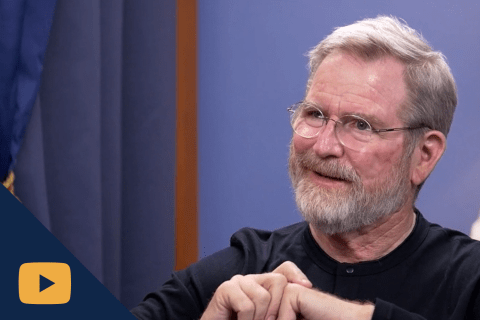
This final article in a series of three is drawn from Dr. Jonathan Reyes’ “Making the Gospel ‘Real’ in a Gnostic World,” delivered as the sixth annual Saint Hildegard Lecture hosted by the University of Mary’s Catholic Studies program. Click here to start from the beginning.
What are we going to do about our present state of affairs? I have five recommendations for how we can strategically address all of this, in no particular order. All of these strategies are informed by a key insight of Newman, about the role of the imagination in leading to belief. I know that there are some arguments about exactly how Newman uses the word imagination, but I think in the broad sense of how he uses it there’s a truth that we can all get our arms around, at least on the tactical level of evangelization.
But first, here are the key insights of Newman that we will need for my five strategic recommendations.
In an essay he wrote in 1841, on the occasion of the opening of the Tamworth Reading Room, and he used it again later in the Grammar of Assent:
The heart is commonly reached, not through reason, but through the imagination, by means of direct impressions, by the testimony of facts and events, by history, and by description. Persons influence us, voices melt us, looks subdue us, and deeds inflame us. Many a man will live and die upon a dogma; no man will be a martyr for a conclusion… No one, I say, will die for his own calculations: he dies for realities.
So the task of evangelization, as Newman saw it, is to take the truths of the faith and present them to people as concrete realities. He wanted to avoid reducing the faith to set up pious abstractions or philosophical proposals about the meaning of life. Jesus is not an idea or simply a good philosopher; instead, he’s a living, concrete incarnation of God. God the Father isn’t simply an abstraction. He’s a living, acting force in a particular history and in a particular people, and we can see his works. It is realities that convert our minds and hearts.
Another distinction Newman made is between notional knowledge and real knowledge. At the risk of oversimplifying, notional knowledge refers to the knowledge we gain through abstract reasoning, while real knowledge refers to our knowledge of particular and concrete things and therefore is largely experiential. The definition of a human being, for instance, is abstract knowledge, while my friendship and knowledge of Msgr. Shea is concrete knowledge. Newman noted that they’re both essential for real knowledge, but that the university has a particular obligation to the notional. He insisted, for instance, that philosophy and theology be the center of the university, and we might observe that many of the other disciplines also depend on abstraction. Without abstraction, we wouldn’t have the theories and models that help us think. Nonetheless, Newman insisted that real knowledge also be part of the university project. So the question becomes one of how we can put these together: how do we appeal to the imagination in a university setting while respecting both of these forms of knowledge and the task of the university?
So here we go: five recommendations.
First, when we preach, we need to preach the concrete reality of the person of Christ. At the end of his Grammar of Assent, Newman takes up the question of how the Apostles were so successful:
When He was gone, His disciples took it upon themselves to go forth to preach to all parts of the earth with the object of preaching Him, and collecting converts in His Name… What were the topics of that preaching which was so effective? If we believe what is told us by the preachers and their converts, the answer is plain. They ‘preached Christ,’ they called on men to believe, hope, and place their affections, in that Deliverer who had come and gone; and the moral instrument by which they persuaded them to do so, was a description of the life, character, mission, and power of that Deliverer, a promise of His invisible Presence and Protection here, and of the Vision and Fruition of Him hereafter.
The Apostles did not preach a doctrine first – they preached a person, and so should we. We should speak about him in the concrete ways we would of someone we know. We should describe his character, his life, and the things he did. We should speak as though we personally know him – because we do. We should talk about how our encounter with him has changed our lives – a change that we hope is evident in the way that we live.
Second, we should tell the story of salvation. In addition to preaching the person of Christ, we also need to tell the story. As human beings, we are, as others have noted, inveterate meaning-seeking beings, and because of this, we are myth-makers. We gain meaning in our lives by understanding the story we are in and the part we are playing in that story. The Apostles did not just preach the person of Christ in a detached, abstract way; instead, they told the story of which he was both author and main character. This was a true history, grounded in real events and located in time, with a beginning and an end. It recounted the concrete action of God in the world, revealing both who we are and who God is. This, too, is a means for making the abstract real, and it speaks to the importance of salvation history in our teaching of the centrality of the Word of God, even at Catholic institutions.
Third, we must preach and foster the encounter of the mysteries of the Faith and the unseen world. At the heart of faith is mystery, and for the mysteries to become real for us, we must encounter them. Both in the imagination – in Newman’s sense – and also concretely in the sacraments and prayer, we need to have this encounter. The same is true for the unseen world – the angelic hosts and the Holy Spirit, for example. To not accept the reality of an unseen world is fatal to Christian belief. As to mysteries, Newman argued that foundational truths of the faith – such as the Atonement, the Incarnation, and the Trinity – run past the limitations of the finite, reasoning mind. They’re too big for us. Therefore the proper response to mystery is not the application of human reason at its most skeptical, but rather the proper response at a certain point in awe, humble exploration, and ultimately, worship. The great mysteries of the faith were things one experienced and entered into, rather than simply scrutinized from afar. Let me draw this out from one of Newman’s sermons on the Trinity. He begins with a brief description of the dogma and then explains how we should encounter and relate to it:
The Eternal Three are worshipped by the Catholic Church as distinct, yet One;—the Most High God being wholly the Father, and wholly the Son, and wholly the Holy Ghost; yet the Three Persons being distinct from each other, not merely in name, or by human abstraction, but in every truth… Now should anyone be tempted to say that this is dark language, and difficult speculation to set before a Christian people, I answer that… Christianity gives exercise to the whole mind of man, to our highest and most subtle reason, as well as to our feelings, affections, imagination, and conscience. If we find it tries us, and is too severe, whether for our reason, or our imagination, or our feelings, let us bow down in silent adoration, and submit to it each of our faculties by turn, not complain of its sublimity of its range.
For Newman it was in the encounter with the mystery that we come to have some understanding of it, and more importantly that we come to truly believe it. He employed a similar strategy when approaching unseen realities. He would use all of his descriptive talents and all the dramatic sense of his imaginative potency to bring before the minds of his readers and hearers those things that we know to be real but cannot test empirically: God himself, the angels, the invisible world behind visible phenomena, and the life of souls after death. He countered the reduced sight of the age by appealing to a wider, richer, and fuller world.
Fourth, we must incorporate real knowledge in the classroom. We’ve already considered the role of notional knowledge and real knowledge in the university, and as we turn to teaching in the classroom, let me reiterate that for Newman, “religion cannot maintain its ground at all without theology.” But as a strategy for evangelization and in order to counter the false gospels of the day with these powerful imaginative visions, he insisted that the truth be presented in a way that appealed to the imagination, as well. Perhaps we can resolve this tension with a simple analogy. For Newman, the educated Catholic needed both a map of reality provided by theology and attended by philosophy and the other sciences, and experiential and concrete knowledge of the realities themselves. The latter came through the imagination by encountering these realities in history, literature, and other fields. To navigate a forest, one needs to know the smell of the earth and the feel of trees, and one needs a map to keep from getting lost or wandering off a cliff. This raises an interesting question for a Catholic university. For historical reasons, the Catholic dimensions of many Catholic universities came to be associated largely with the number of theology courses in the curriculum and the sacramental life. In the current moment, however, a different movement is called for. If Newman is correct, theology as an academic discipline is not likely to lead to belief in the Gospel simply because it is by design meant to deal with abstractions rather than concrete, particular realities. So how and where do we create opportunities for the Gospel to reach people through the imagination in a serious college course? In what ways can the curriculum foster that belief which Newman described as “concerned with things concrete, not abstract, which variously excite the mind from their moral and imaginative properties, has for its objects, not only directly what is true, but inclusively what is beautiful, useful, admirable, heroic; objects which kindle devotion, rouse the passions, and attach the affections”?
I suspect there are appropriate ways for Newman’s insights to be applied to theology classes as well as those of other disciplines. But let me take a slightly firmer ground as I throw some suggestions out there and talk about my own field, history. Here I simply want to point out that I think Dawson’s proposal for what he called the study of Catholic culture has things to model for us. For Dawson, the past was not to be understood as a series of random events, nor was it driven primarily by material factors. The history of culture was to be understood first from the standpoint of the cult that was created and continued to sustain and guide it. This applied in every culture, but for the Christian, it’s important as revealing the way in which faith in Jesus Christ found expression in cultural form. So Dawson proposed to study that process by which the invisible truths of the faith took on concrete expression and so became more real. To read the stories, the sermons, and the literature that made the faith a reality in the culture and to study the visual arts that did the same was to watch the imaginative power of the Gospel at work. In culture, we see the invisible being made visible. We see the encounter with mystery made concrete. It was also in this way to see the power of the truth as it found its way to renew human hearts in the testimonies and lives of the saints. To read about devotion to Mary, for example, was to see her as a concrete reality affecting lives and inspiring the love of millions not as an idea, but as a person. Thus history, while being faithful to its task of recounting and seeking to understand the past, is also a tool for reaching the imagination through concrete, specific examples of lived faith. I think this is the kind of conversation we can have with other disciplines, as well. This takes serious reflection, particularly in a modern university, which is premised on the isolation of the disciplines and the questionable conviction that there is some purely neutral space from which truth can be examined. The modern university in its assumptions is not built for this. Yet a Catholic university may, without losing any of its professional rigor, high standards, or openness to honest inquiry, ask how it can nonetheless make available without coercion the encounter with the truths of the faith as living realities. This is an important question that a community of Catholic scholars can only answer for themselves.
Fifth and finally, we must foster true friendship. Newman’s emphasis on the need to examine and scrutinize first principles put a special emphasis on friendship. Why? Because it was his conviction that it was primarily in meaningful conversations with friends that one was best able to examine one’s first principles. In a letter to William Froude in 1879, Newman agreed with his friend that “men must have chronic familiarity to understand each other, and that truth slowly sinks into the mind, and that therefore the paper argument is most disappointing.” This was a conviction Newman shared with Aristotle and it raises an important consideration for the modern Catholic university regarding the kind of community we create. It’s important to look for ways to order the university to meaningful friendships among administrators, among faculty members, among students, among faculty members and students – these friendships need to be characterized by the kind of sustained, deep, and trusting conversation that allows one to honestly recognize and then examines one’s first principles. This is something a classroom can’t do, and I would posit that a lot of the students coming to us haven’t had these kinds of conversations, don’t yet have these kinds of friendships, and have some first principles that oppose the very axioms of the faith. A deliberate effort to foster true friendship is essential to a Catholic university concerned with evangelization.
I conclude. Reinhard Huetter summarized the modern ideological landscape as follows: “The only significant struggle in late-modern, technologically advanced, economically consumer-capitalist, and politically liberal societies of the Western hemisphere is to avoid at all costs being subjected to the sovereignty of others and simultaneously to maximize one’s own possibilities of exercising subjective sovereignty.” I think this is a revealing summary and gets to the essence of the modern Gnostic challenge, namely, the sin of pride – the reign of the sovereign self. At the bottom, the errors of many of the modern ideological religions stem from a moral failure, rather than an intellectual failure: the dream of becoming like a god. This suggests that the most important evangelistic strategy, in the end, is a moral one: the fostering of humility. That’s not an easy thing for a university for obvious reasons. The intellectual life provides an easy path to pride. That’s why the religious who founded our universities made the pursuit of humility such a goal. Humility, like all virtues, is something that we must practice. It finds expression not only in our words – false humility is easy – but in the ways we accept adversity with patience, do not insist on our own way, bear up under humiliation, honor others and put their needs before our own, and most importantly, in how we worship. It is only in the right relationship with God as his creatures, made in his image, established in our identity by him, freed from sin and death by his sacrifice, subject to his decrees, and dependent entirely on him for our existence at every moment, that we will come to bear effective witness to him as our real and loving Father. Humility is the secret power of evangelization. So perhaps it’s appropriate to end a talk on evangelization with a simple prayer of the monks who waged such an implacable war on the sin of pride: “Lord Jesus Christ, son of the living God, have mercy on me, a sinner.”

Previous: The Gnostic Ideologies of the Modern Age
Many people in the West have accepted one of two modern narrative visions of the world: the techno-nationalist vision and the equity-justice vision. What do these visions have to say about human life?


